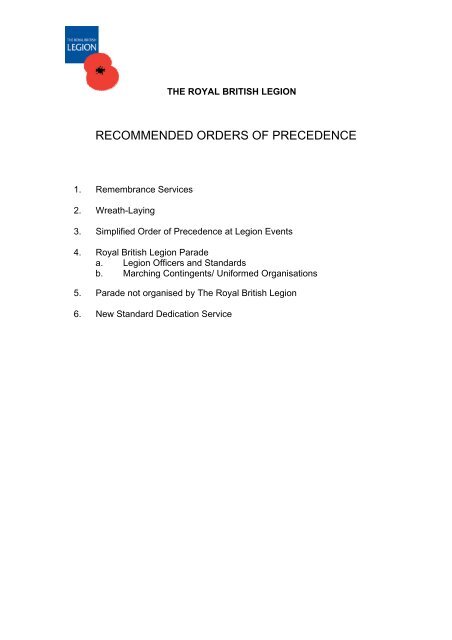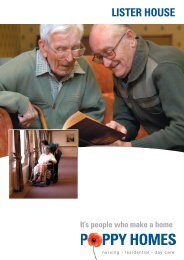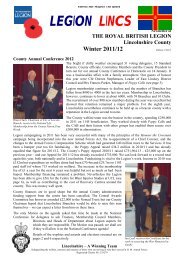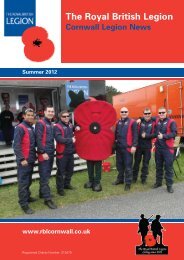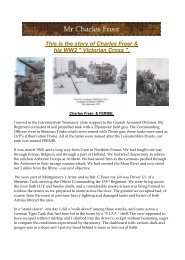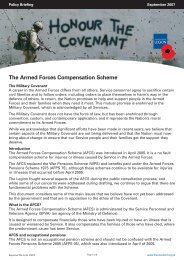Recommended Orders of Precedence - The Royal British Legion
Recommended Orders of Precedence - The Royal British Legion
Recommended Orders of Precedence - The Royal British Legion
You also want an ePaper? Increase the reach of your titles
YUMPU automatically turns print PDFs into web optimized ePapers that Google loves.
THE ROYAL BRITISH LEGION<br />
RECOMMENDED ORDERS OF PRECEDENCE<br />
1. Remembrance Services<br />
2. Wreath-Laying<br />
3. Simplified Order <strong>of</strong> <strong>Precedence</strong> at <strong>Legion</strong> Events<br />
4. <strong>Royal</strong> <strong>British</strong> <strong>Legion</strong> Parade<br />
a. <strong>Legion</strong> Officers and Standards<br />
b. Marching Contingents/ Uniformed Organisations<br />
5. Parade not organised by <strong>The</strong> <strong>Royal</strong> <strong>British</strong> <strong>Legion</strong><br />
6. New Standard Dedication Service
1. Remembrance Services<br />
<strong>The</strong> only person whose precedence at Remembrance services is absolute is Her Majesty the<br />
Queen. <strong>The</strong> precedence <strong>of</strong> all others, despite what appears in the published Table <strong>of</strong><br />
<strong>Precedence</strong>, may vary from time to time depending on local traditions, the relationship<br />
between host and guests, and the requirements <strong>of</strong> courtesy and hospitality.<br />
Normally, an acceptable compromise can be reached provided there is adequate consultation<br />
beforehand. It is most important to avoid embarrassment. Assuming that all those listed are<br />
participating and that the Lord Lieutenant or his representative is not present (otherwise he<br />
would take precedence as the Sovereign's representative) and subject to prior consultation<br />
and agreement the following sequence is recommended for assembly at a local War<br />
Memorial for a Remembrance service:<br />
1. Band.<br />
2. Clergy and choir.<br />
3. Civic VIPs (Mayor, Chairman <strong>of</strong> Council).<br />
4. Union Flag (if on parade).<br />
5. <strong>Legion</strong> and Women's Section Standards.<br />
6. Standards <strong>of</strong> other ex-Service associations (RNA, Army, RAFA).<br />
7. Regular forces (RN, Army, RAF).<br />
8. Territorial and reserve forces.<br />
9. Ex-Service contingents (preferably in one group, but may be in columns by<br />
Service and corps, normally with the <strong>Legion</strong> leading though there may be<br />
variations).<br />
10. Uniformed public services (Police, Fire Brigade, Ambulance services, St John<br />
Ambulance, Red Cross etc).<br />
11. Youth organisations (led by Service cadets, then uniformed organisations<br />
followed by non-uniformed bodies).<br />
12. Members <strong>of</strong> the public (who should be invited to participate in the public<br />
Remembrance event).
2. Wreath-Laying<br />
Subject to prior consultation and agreement, and assuming that all those listed are<br />
participating, the following sequence is recommended for assembly at the local War Memorial<br />
for wreath-laying. It is also assumed that the Lord Lieutenant or his representative is not<br />
present otherwise he would take precedence as the Sovereign's representative.<br />
1. Civic VIPs<br />
2. Representatives <strong>of</strong> regular forces.<br />
3. Representatives <strong>of</strong> territorial and reserve forces.<br />
4. Representatives <strong>of</strong> ex-Service associations, including the <strong>Legion</strong> & Women's<br />
Section.<br />
5. Representatives <strong>of</strong> uniformed public services (Police, Fire Brigade, Ambulance<br />
services).<br />
6. Representatives <strong>of</strong> uniformed voluntary services (St John Ambulance, Red<br />
Cross, etc).<br />
7. Representatives <strong>of</strong> cadet forces.<br />
8. Representatives <strong>of</strong> youth organisations.<br />
9. Members <strong>of</strong> the public.
3. Simplified Order <strong>of</strong> <strong>Precedence</strong> at <strong>Legion</strong> Events<br />
Assuming that a member <strong>of</strong> the <strong>Royal</strong> Family is not present, the following simplified Table <strong>of</strong><br />
<strong>Precedence</strong> would normally apply for those attending a <strong>Legion</strong> event. However, there may be<br />
local variations so local consultation is crucial.<br />
1. <strong>The</strong> Lord Lieutenant <strong>of</strong> the County in which the event is held or his<br />
representative.<br />
2. Archbishop, (Canterbury or York – special occasions).<br />
3. <strong>The</strong> Prime Minister or a Secretary <strong>of</strong> State.<br />
4. A Bishop or Moderator (Reformed Church) attending as a guest and not<br />
conducting a service.<br />
5. <strong>The</strong> Lord Mayor and other Mayors and Chairmen <strong>of</strong> Councils<br />
6. <strong>The</strong> Recorder <strong>of</strong> the Borough.<br />
7. <strong>The</strong> High Sheriff <strong>of</strong> the County.<br />
8. <strong>The</strong> Lord Chief Justice.<br />
9. Privy Councillors.<br />
10. Senior Officers <strong>of</strong> the Military Forces.<br />
11. Judges.<br />
12. <strong>The</strong> Head <strong>of</strong> the Civil Service and other Senior Civil Servants.<br />
13. <strong>The</strong> Chief Constable.
4. <strong>Royal</strong> <strong>British</strong> <strong>Legion</strong> Parade<br />
a. <strong>Legion</strong> Officers and Standards<br />
On parade, the senior <strong>Legion</strong> Standard must give precedence to the Union Flag. <strong>The</strong>re shall<br />
be only one Union Flag on each parade and it is carried usually by the senior Standard<br />
Bearer. <strong>The</strong> precedence <strong>of</strong> <strong>Legion</strong> Standards follows the seniority <strong>of</strong> <strong>Legion</strong> formations, i.e.<br />
National, County/District, Group (where relevant), Branch (normally led by the local Branch,<br />
followed by other Branch Standards). Members <strong>of</strong> the Board <strong>of</strong> Trustees will march behind<br />
the Union Flag and the National Standard. Members <strong>of</strong> the County/District Committee will<br />
march behind the County/District Standard. A VIP may be invited to march alongside the<br />
parade commander. <strong>The</strong> Branch President would follow with the other <strong>of</strong>ficers <strong>of</strong> the Branch,<br />
and then the Branch members. Dressing <strong>of</strong> ranks during the march past is important giving a<br />
good impression.<br />
b. Marching Contingents/ Uniformed Organisations<br />
If it is a <strong>Legion</strong>-organised parade, <strong>Legion</strong> Standards and Women's Section Standards should<br />
take precedence, and be followed in order by <strong>Royal</strong> Naval Associations, Army Regimental or<br />
Corps Associations and <strong>Royal</strong> Air Force Association Standards. <strong>The</strong> same sequence applies<br />
to adult marching contingents. When service and other youth contingents are on parade it is<br />
recommended that service cadets lead those contingents in the traditional sequence, followed<br />
by other uniformed organisations (Boys Brigade, Scouts, Guides, St John Ambulance, Red<br />
Cross, etc) and finally any non-uniformed youth organisations. Colours and Standards <strong>of</strong><br />
youth organisations should be grouped at the head <strong>of</strong> the youth contingents on parade.
5. Parade not Organised by <strong>The</strong> <strong>Royal</strong> <strong>British</strong> <strong>Legion</strong><br />
If a parade is organised by the civil authorities, for example for dedicating or re-dedicating<br />
their War Memorial, or a special remembrance ceremony, then it is not a <strong>Legion</strong> parade and<br />
the sequence <strong>of</strong> contingents is a matter for the organising body. <strong>The</strong> <strong>Royal</strong> <strong>British</strong><br />
<strong>Legion</strong> Standards are not carried, unless they are specifically invited by the civil authority to<br />
parade. <strong>The</strong> Cenotaph Parade and service on Remembrance Sunday are examples <strong>of</strong><br />
parades not organised by the <strong>Legion</strong> – they are managed by a Government Department.
6. New Standard Dedication Service<br />
For the march to the Church:<br />
<strong>The</strong> parade is formed up in threes facing in the direction <strong>of</strong> the march, in the following order:<br />
• <strong>The</strong> Band<br />
• County/District Standard <strong>Royal</strong> <strong>British</strong> <strong>Legion</strong> & <strong>Royal</strong> <strong>British</strong> <strong>Legion</strong> Women's<br />
Section<br />
• County/District Officers<br />
• Massed Standards (two or three ranks depending on numbers)<br />
• <strong>The</strong> Old Branch Standard with Escorts<br />
• Branch Officers and Branch Members<br />
• Other Branches and Ex-Service Associations<br />
• Cadet Units<br />
• <strong>The</strong> Branch Chairman (with the new Standard furled) with Escorts<br />
For the march from the Church via a Saluting Dais to the reception:<br />
County/District Standard Bearers make their way to the Saluting Dais and position<br />
themselves either side <strong>of</strong> it to act as guides for the “Eyes Left/Right” and “Eyes Front” as the<br />
Parade marches past.<br />
<strong>The</strong> Parade then re-forms in threes facing the direction <strong>of</strong> march in the following order:<br />
• <strong>The</strong> Band.<br />
• <strong>The</strong> New Branch Standard.<br />
• <strong>The</strong> Branch Officers and Members.<br />
• County/District Officers.<br />
• Massed Standards.<br />
• Other Branch Members and Ex-Service Associations.<br />
• Cadet Units.


